
Men's Jeans - The Ultimate Guide
Jeans, denim, blue jeans, whatever you call them – the bottom line is that they’re a staple in every man’s wardrobe. Every man, no matter his age or body type, should have a few different pairs of jeans in his closet.
The color, fabric type, and cut of your jeans can heavily impact how good or bad they look on you, as well as how comfortable you'll be while wearing them. Ignore these details at your own peril!
Summarize with AI
Quick Links
- Frequently Asked Questions
- 6 Ways Men Wear Jeans Wrong
- Anatomy of Jeans
- Color, Wash & Fading
- 4 Essential Jean Colors To Own
- Different Types of Denim
- Common Styles or Fits of Jeans
- How Men's Jeans Should Fit
- Best Jeans For Your Body Type
- Best Ways To Pair Jeans With Shoes
- How to Wash, Dry & Care For Your Jeans
- Outfit Ideas
Frequently Asked Questions
What is a 'wash'?
The 'wash' refers to the treatment process that affects the color and texture of denim. Light wash jeans have a faded appearance, while dark wash jeans retain a deeper hue. Dark blue or indigo washes are versatile, flattering, and suitable for both casual and elevated casual occasions.
Can I wear jeans with a denim jacket?
The matching-jeans-and-jacket look, AKA the 'Canadian Tuxedo' is never a good look.
That said you can wear denim pieces that have contrasting colors. For example: pairing black jeans with a mid-wash denim jacket.
Should I wear jeans with a button or fly?
This ultimately depends on personal preference and comfort. Jeans with a button closure provide a classic and timeless look, while jeans with a fly typically offer a more convenient and practical option.
What styles of jeans are most flattering for men?
The most flattering jeans complement your body type and personal style. Slim or straight-leg cuts are generally versatile and suit various builds. It's essential to choose a fit that provides comfort and confidence.
How do I find the right jeans for my body type?
Understanding your body proportions is key to selecting suitable jeans. For athletic builds, consider straight cuts to accommodate muscular thighs. Slim builds may benefit from slim-fit jeans to add definition, while relaxed fits can offer comfort for larger frames.
What jean cut is in style right now?
It depends on your objectives with jeans, but if you want to ensure you look good now and 10 years from now in your jeans, you should stick to jeans that properly fit your body. This may sound silly or "Well, duh", but most men don't know what this even means. This is a subject that is extensively covered in this article, so keep reading to determine what jean cut is best for you, and don't worry about what's "in style" right now because properly fitting jeans always look good, no matter what the trends are.
Which jean cuts are currently in style?
Fashion trends evolve, but classic cuts like slim and straight-leg jeans remain timeless. While skinny jeans have seen fluctuating popularity, it's advisable to choose styles that align with personal preference and body type rather than transient trends.
What jeans are appropriate for a 50-year-old man?
Age doesn't restrict jean choices. Focus on well-fitting, classic styles in darker washes for a sophisticated look. Straight-leg or slightly tapered jeans offer a balanced and age-appropriate appearance.
Can men over 30 actually pull off wearing skinny or slim jeans?
Slim jeans, yes. Skinny jeans, no. Read the rest of this article to learn the difference and why it matters.
Do slim fit or skinny jeans look good on guys?
It entirely depends on your body type and measurements. If you have the right body type for them, then they'll look great. If you don't, they wont. Read this article to determine if they'll look good on you or not.
Is it better to get a size bigger or smaller in jeans?
Selecting the correct size is crucial. Jeans should fit comfortably at the waist without a belt and allow for ease of movement. Avoid sizes that are too tight or too loose; the right fit should feel natural and unrestrictive.
Straight fit vs Slim fit – Which to try?
The way jeans are cut is one of the most important factors to consider for jeans. However, don't let the name of the style sway you - you want jeans to fit your body type based on specific measurements, not the cut.
The cut or style will only help inform you which direction to go, the measurement details discussed in this article will determine which one you should actually try on.
Is it better for jeans to be tight or loose?
Jeans should strike a balance between fitted and comfortable. Overly tight jeans can restrict movement, while excessively loose jeans may appear unkempt. Aim for a fit that contours to your body without constriction.
Do jeans get looser or tighter over time?
Jeans, especially those made from 100% cotton denim, tend to loosen with wear as the fabric stretches. However, after washing, they may tighten slightly before relaxing again with use. Incorporating a small percentage of elastane can provide added flexibility and help maintain shape.
Do men look good in low-rise jeans?
No, they do not, avoid them at all costs unless you're going for a very specific look and really know what you're doing.
Hint: If you're reading this, you aren't at the level to determine this.
What brand of jeans last the longest?
Provided you care for them properly, any brand of jeans will last a long time since the fabric of denim is very robust and can last for years with proper care.
Which is better: Lee, Wrangler or Levis?
They're all good if they fit your body well. Read the rest of this article for how to determine that.
What jeans fit men with big thighs?
Most brands will fit bigger thighs if you know what to look for and how to determine the best jeans to get for your specific attributes.
This is all explained in this article.
Where can I get decent quality but cheap men's jeans?
Lots of stores carry good quality jeans at reasonable prices.
Some of my favorites include Target, H&M, Uniqlo, Topman, Zara, Levi's, Gap, and Banana Republic.
Fit, color, and price, these are the things that you should care about the most.
What do the Levi's numbers (501, 513, etc.) mean?
Levi's jeans use a numbering sequence, beginning with the 501, but the reason for the 501 designation is unclear. Around 1890, Levi's started calling their copper-riveted waist overalls the 501, according to an executive at Levi's. The mystery surrounding the number is largely due to the San Francisco earthquake of 1906 that destroyed many of the company's files. So now, in honor of the original designations, all Levi's fits are denoted by a number: 501, 505, and 511, with each number denoting a cut designed for a specific style.
Which are better - Stretch or 100% cotton jeans?
Jeans that contain some stretch in the fabric are more comfortable since they're more forgiving. But some people prefer the feel of 100% cotton jeans, so it's more of a personal choice. Try both versions and see which you like best.
How do I wash my jeans?
If you're looking to make your jeans last as long as possible, then you should only wash them when they smell or have stains, otherwise turn them inside out and air them out overnight or between wears.
When you need to wash them: Use cold water and a color-preserving detergent and put them on a gentle wash cycle and then only air dry them to preserve the shape and color the longest. If you have the means or are lazy, you can also get them dry-cleaned.
Do I need to wear a belt with my jeans?
Ideally, if they fit well, you don't need a belt. However, denim does stretch a little as you wear it, so you may need a belt, which is totally fine. To alleviate this problem, get jeans that are just a little tight in the waist and they'll relax to fit perfectly.
What's the difference between 'selvedge' and 'raw' denim?
'Selvedge' or 'selvage' refers to the clean and finished edge of denim fabric.
The self-finished edges prevent the fabric from unraveling. The narrow fabric, woven on traditional shuttle looms, results in a higher quality jean compared to stretch fabric jeans – the quality determines the cost of selvedge jeans.
Raw denim refers to denim that is unprocessed, untreated, and not pre-washed. They can also be called dry denim.
Raw jeans are indigo denim made straight off the looms and will develop a unique, personal look to them as you wear and break them in. Most jeans that aren't selvedge or raw will also develop a uniquely personal look as you wear them, so don't think it's only applicable here.
Read the rest of this article for even more details.
Do I need to 'break in' my jeans?
Probably not. This mostly applies to raw and/or selvedge jeans since they are literally "raw" and untreated.
Most jeans in stores are already washed and treated so what you're buying off the rack is technically already "broken in." They may stretch a little and will fade with wear and washing, so if that's what you're meaning by "breaking in", then all jeans will break themselves in as you wear them.
How do I find my size in jeans?
Jeans sizes are based on two measurements: waist circumference, or waist width (W), and length (L) of the leg also known as the inseam. The waist/length ratio is given in inches (in).
For example: a waist size of 32 inches and leg length of 30 inches is a jeans size of 32×30. Some brands also use alpha (alphabetical) sizing: XS, S, M, L, XL, XXL, etc.
6 Ways Men Wear Jeans Wrong
I see so many guys making the following mistakes, so I want you to be aware of them:
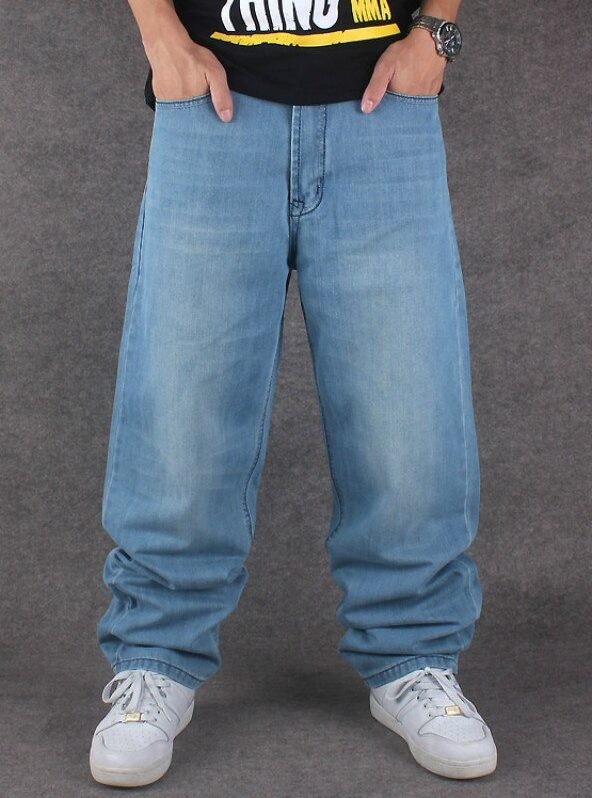
Too Baggy
Overly baggy jeans have an aesthetic that's unflattering, sloppy, and childish.
Basically, they make slim guys look skinnier and big guys look bigger.
Your jeans should fit your body type and be proportional to your build.
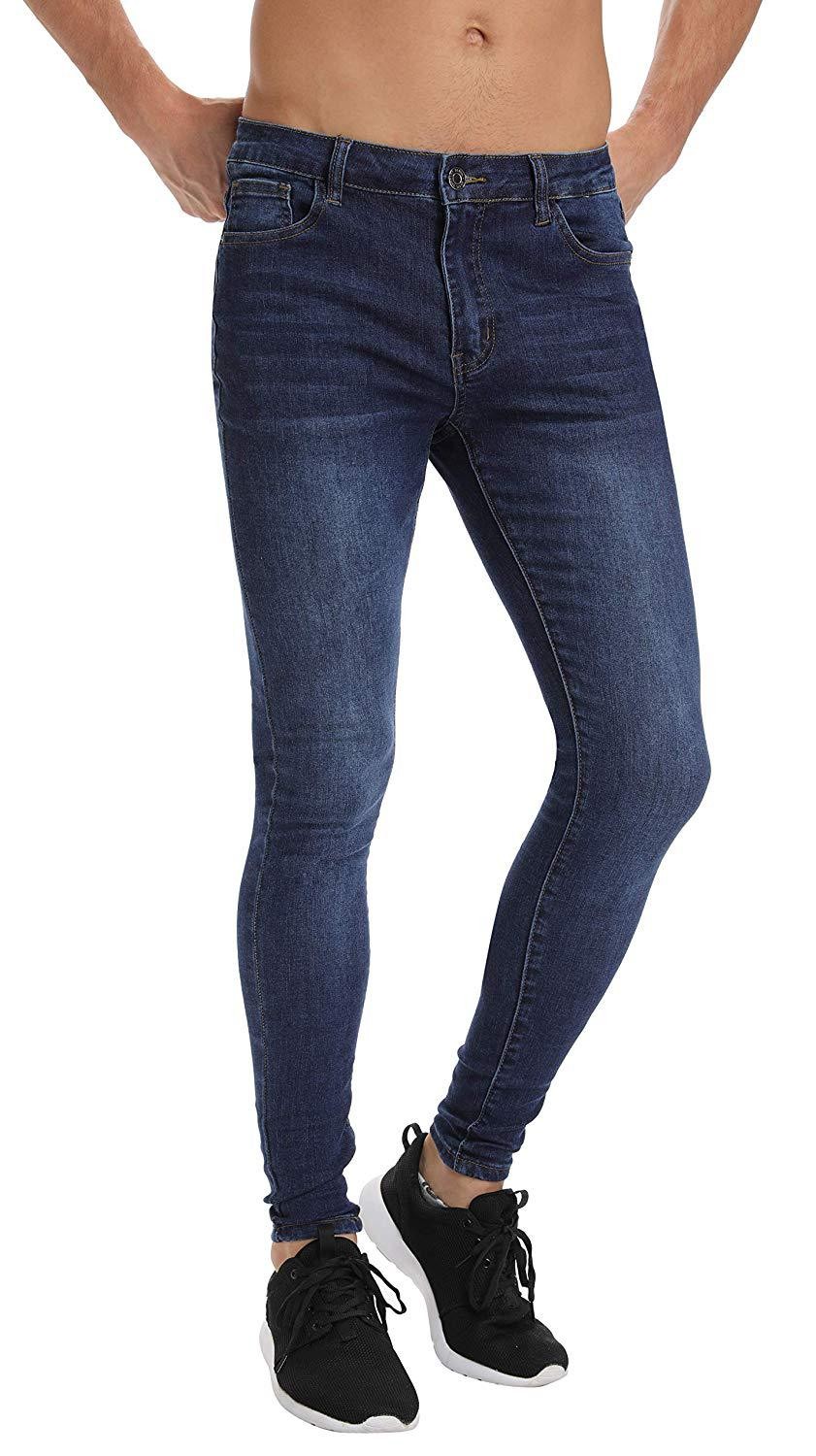
Too Tight
The right taper is important but overly tight is just plain wrong.
This makes you look both juvenile and unaware of how to dress well or for your body type.
If you're wearing jeans to work, it also looks unprofessional, regardless of how casual your work environment.
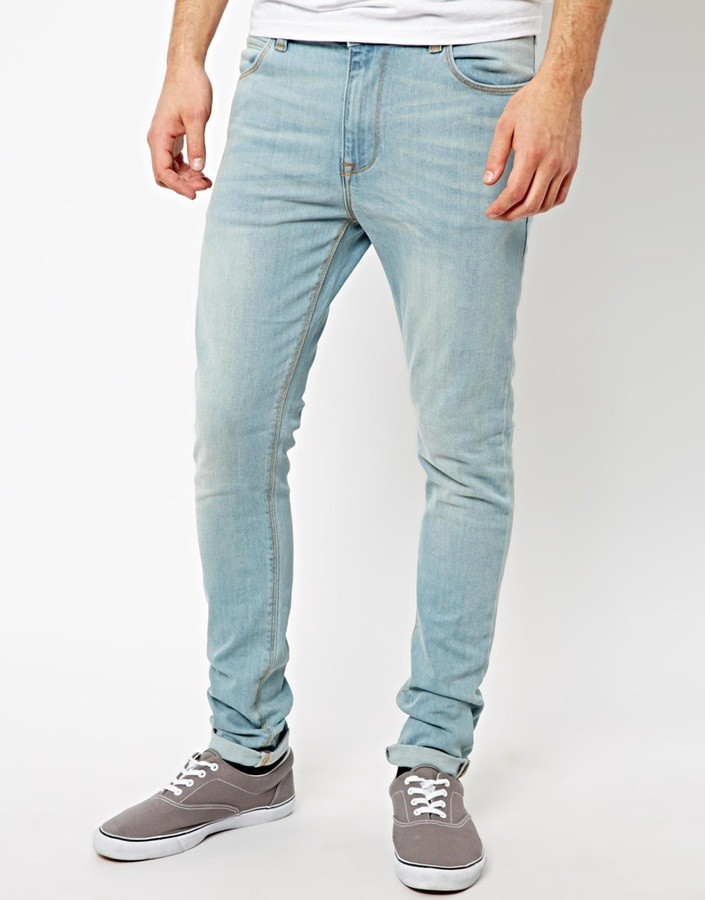
Too Light
Washes that are too light (very light blue or grey/white) or acid-washes are neither
timeless or versatile.
They ultimately make you look like you’re trying too hard to be trendy.
Keep your jeans in a clean, dark wash (color) or one of the other colors listed below.

Ripped
For 95% of men over the age of 25, distressed or ripped jeans are never a good look.
Like some of the lighter washes, these will make you look like a teenager.
A little distressing or fading is fine, but only if you’re under the age of 25.

Too Long
This looks sloppy and can ruin an otherwise good outfit.
It can make you look really short, which is not flattering at all.
Find the right length and go to a tailor, it’s a simple $5-10 fix.
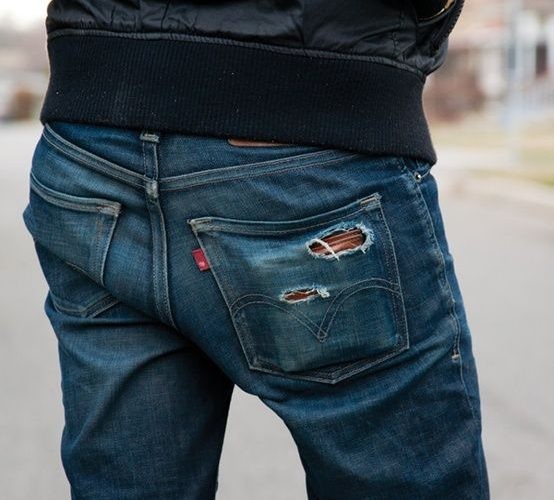
Saggy Butt
Find the right fit in the seat – proper rise (discussed below), as well as how loose they are in the thigh area is crucial.
You want a trim (but not overly tight) fit.
Want to learn how to look amazing in jeans, specifically for your age, height, body type, and skin tone? Check out my Essential Capsule Wardrobe App.
Anatomy of Jeans
Here are some of the key things to look out for when shopping for your next pair of jeans:
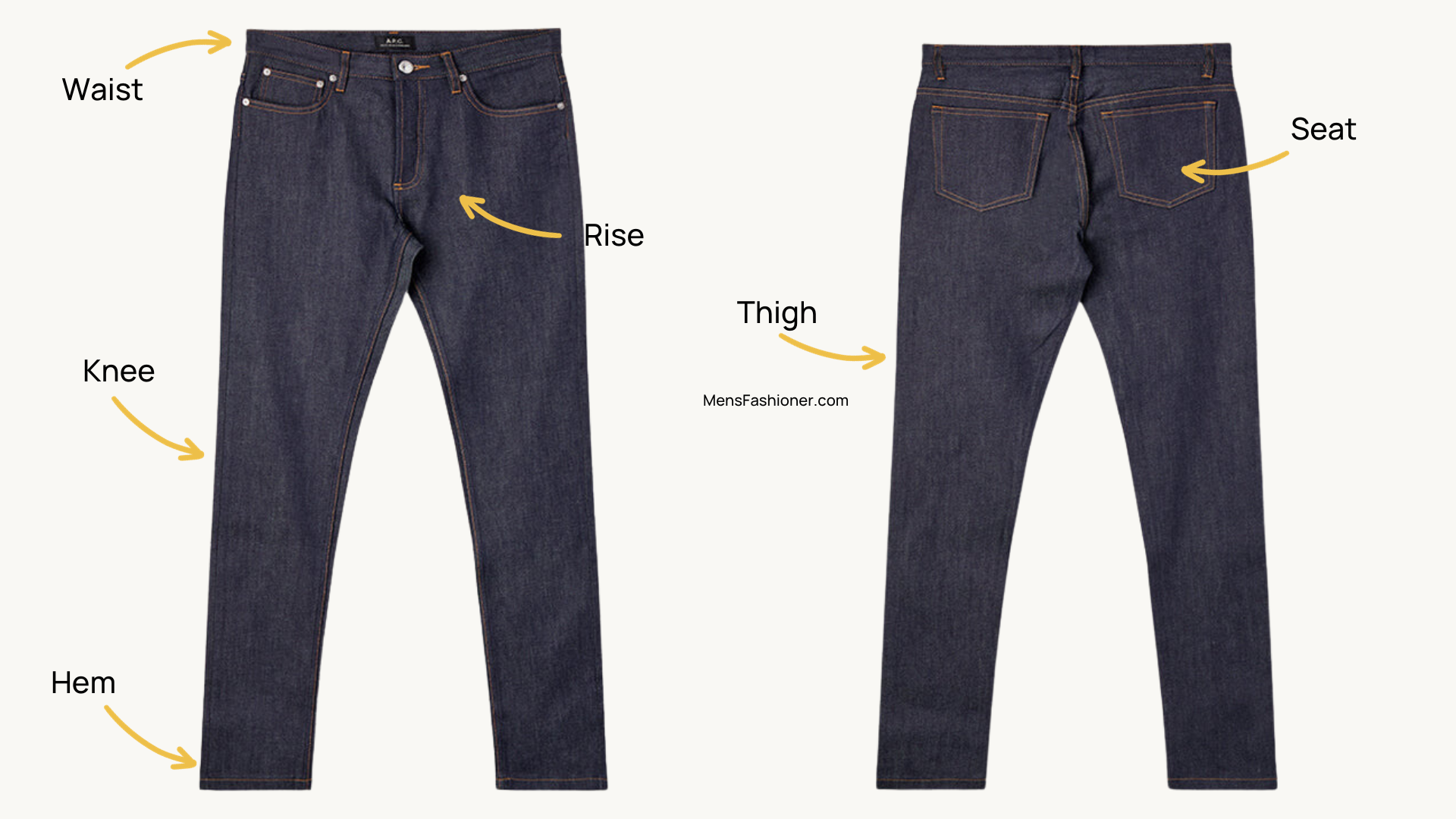
Waist
Jeans should sit comfortably at your waist at the mid-to-upper hip, fitting perfectly at the waist without a belt. This placement prevents a droopy seat and keeps your look sharp and polished.
Rise
The rise, measuring 7–12 inches (17.75–30.5 cm), is the distance from the crotch seam to the waistband. It determines where your pants sit and shapes your waistline and overall fit. There are three types of rise:

Low-Rise Jeans: Sit below your natural waist, closer to your hips. Popular in the 60s and 70s, they’ve made a comeback with Gen Z.
Mid-Rise Jeans: Typically 9–11 inches (23–28 cm), designed to sit at your natural waist. Also known as regular or normal rise, this is the most versatile and common option—perfect for most men.
High-Rise Jeans: Over 10 inches (25.5 cm) and ideal for men over 6 feet tall who prefer their pants at the waist rather than the hips. Found in "big and tall" stores, these have a more traditional fit but may feel out of place in today's trend of mid-rise jeans.
Seat
The seat should fit snugly without being tight or saggy; if it feels restrictive or looks unflattering, try a different fit or tailor the upper thighs as a last resort.
Thigh
The amount of fabric you can pinch on your thigh depends on the jeans' cut and your body type. If there's excess fabric, try a different style or size, or consider tailoring the legs as a last resort.
Knee
The knees of your jeans shouldn’t fit too tight but lie comfortably close without feeling like it’s pulling tightly when you walk or bend down. There should definitely be no rips or tears around the knee area.
Break
The "break" refers to the fold or crease in the fabric at the front of your pant leg, just above where the hem meets your shoe when standing.
Jeans should be long enough for a full or half break for a sharp, polished look. If they're too long, have them hemmed—it's affordable and worth it. Avoid jeans with a negative break, as they're too short to fix.
Here are the different types of pants breaks:

Full Break

Half Break

No Break

Negative Break
Color, Wash & Fading
Color and wash are often used interchangeably by brands, but they have distinct meanings.
Denim that hasn’t been washed retains more of its original dye, making it darker. With each wash, the dye fades, resulting in a lighter appearance. Technically, a dark wash refers to denim that is unwashed or washed minimally, while a light wash indicates more extensive washing.
In simple terms:
Light wash = lighter-colored denim.
Dark wash = darker-colored denim.
When shopping, these terms primarily describe the depth of the denim's color.
4 Essential Jean Colors To Own
The four colors of denim to go for are dark indigo/blue, a medium blue wash, grey, and black. Anything outside of these colors will have very limited use cases or not be appropriate depending on your age, height, skin tone, or body type.
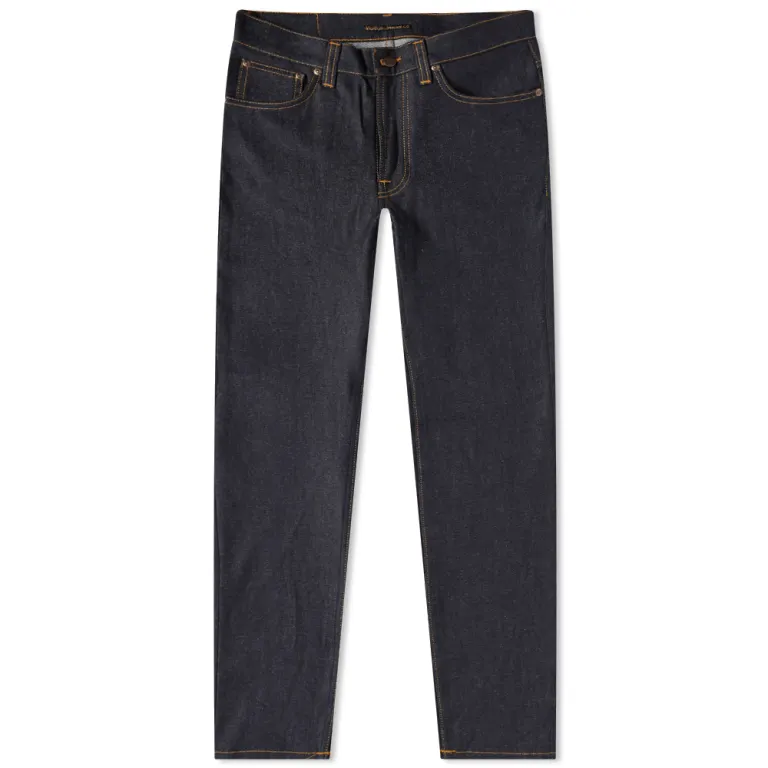
Dark Wash (Indigo Blue)
If you own just one pair, dark wash indigo blue is the one to own, so buy these first! It’s the most versatile and can be worn dressed up with something like a blazer and loafers or with everything casual like sneakers and a t-shirt.
If you work in a business casual office, dark indigo jeans are a great alternative to chinos on casual days.
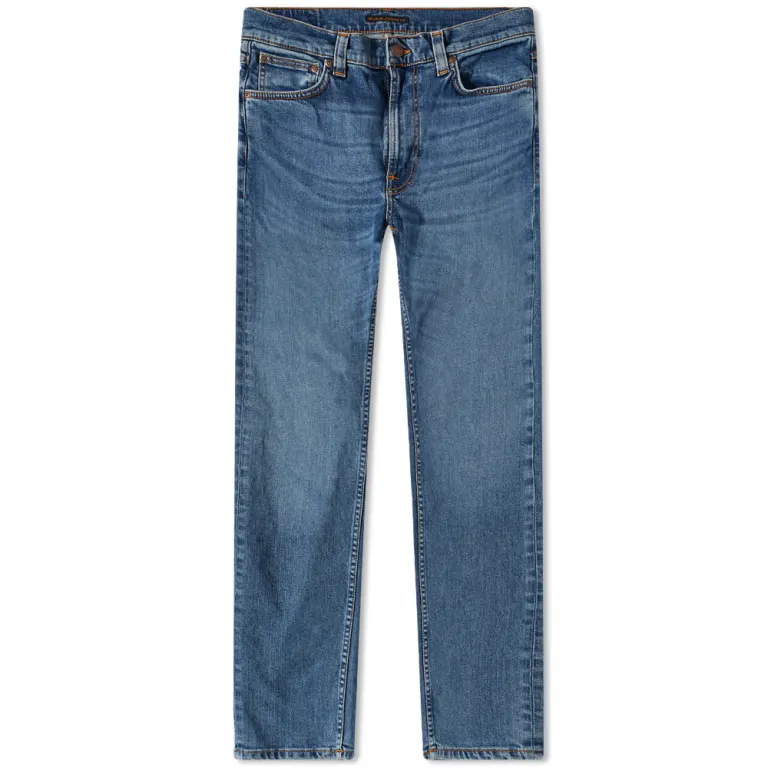
Medium-Wash Blue
Not as versatile as a darker wash, use a lighter medium-blue shade for more casual situations or for wearing during warm weather.
Be careful not to go too light on the wash as the very light shades tend to be a bit too trendy and can veer a bit too adolescent.
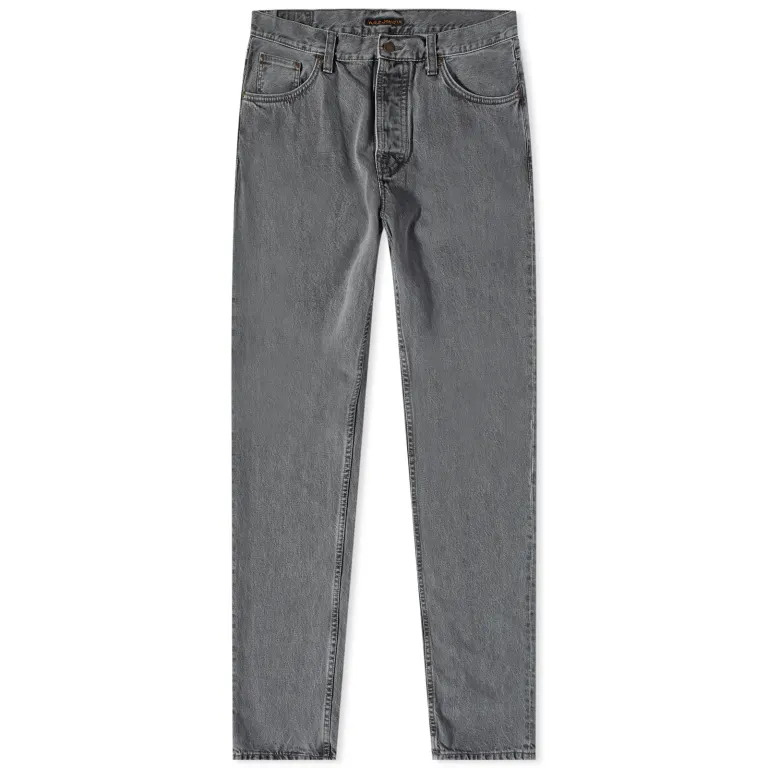
Gray
While not as important as dark blue jeans, grey jeans can be quite versatile. Stick with a medium to darker grey wash and don’t be afraid to dress them up.
Think of them kind of like a pair of grey chinos in terms of how and where you would wear them.
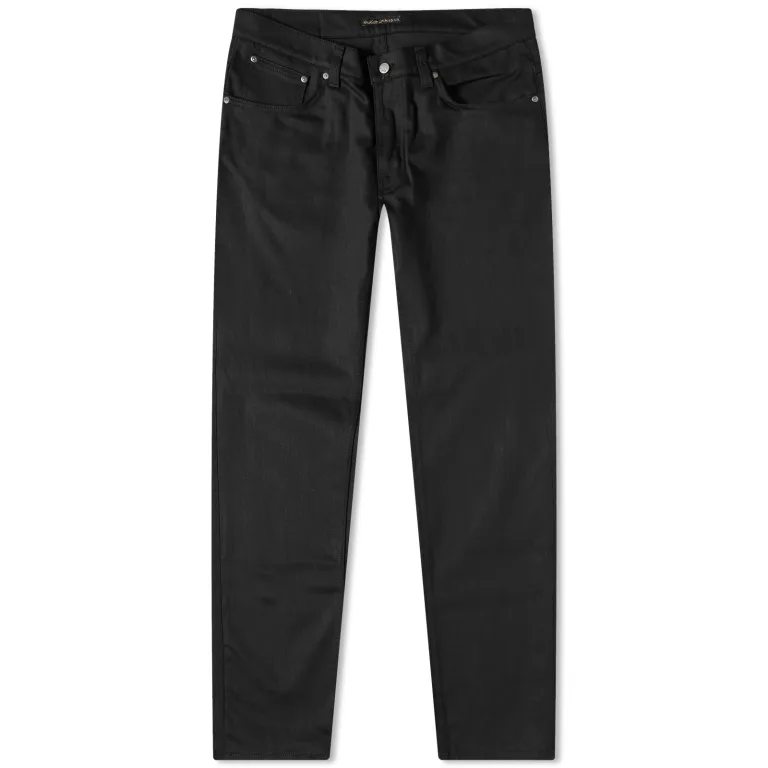
Black
A good pair of black jeans are almost as vital to your wardrobe as dark indigo jeans. They also have a little bit of a rocker vibe to them and look great for nighttime occasions.
You can never go wrong with a pair of black jeans, a white or grey shirt, and a pair of sneakers or boots.
Different Types of Denim
Jeans are always made from denim, which is a cotton twill fabric known for its strength and its ability to withstand regular wear and tear.
However, it's important to understand that there are different types of denim to choose from depending on your personal style and desired level of durability or flexibility.
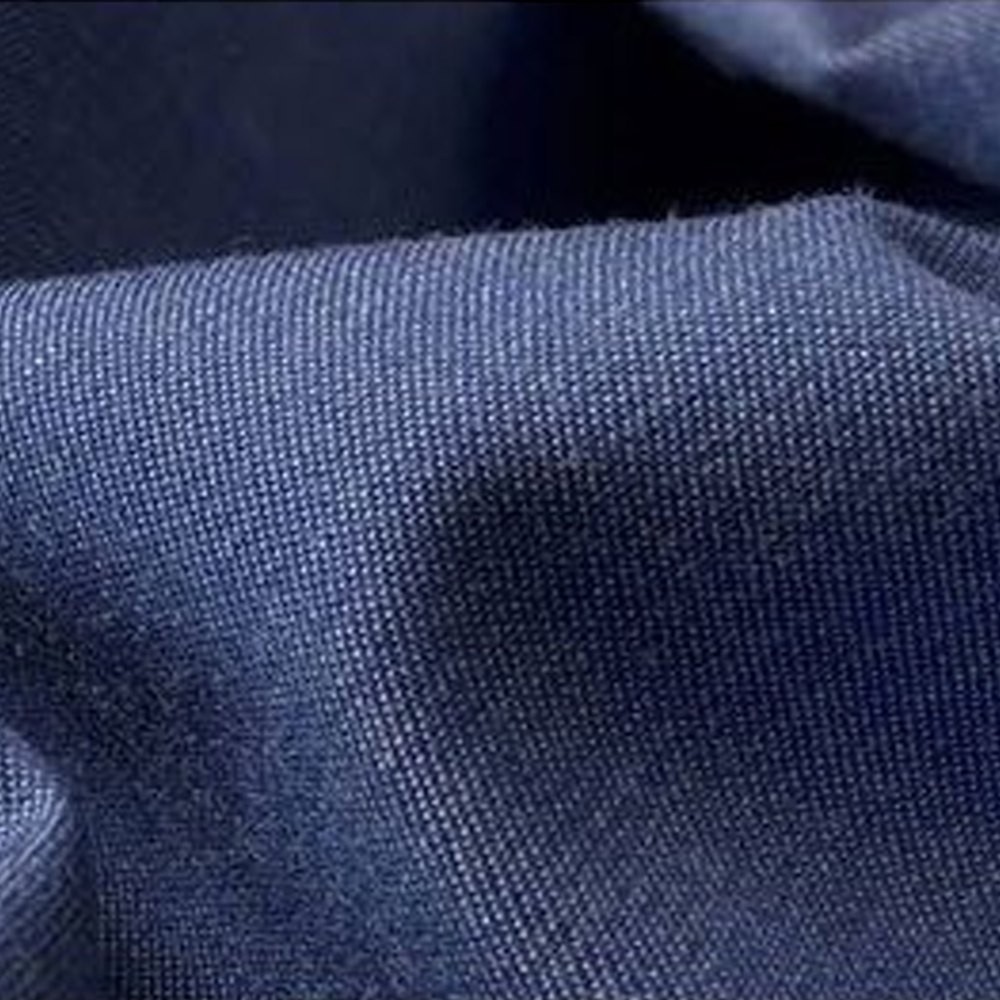
100% Cotton Denim
This is the original and most common type of denim. It's super durable and versatile and can be softer and more breathable than other types of denim.
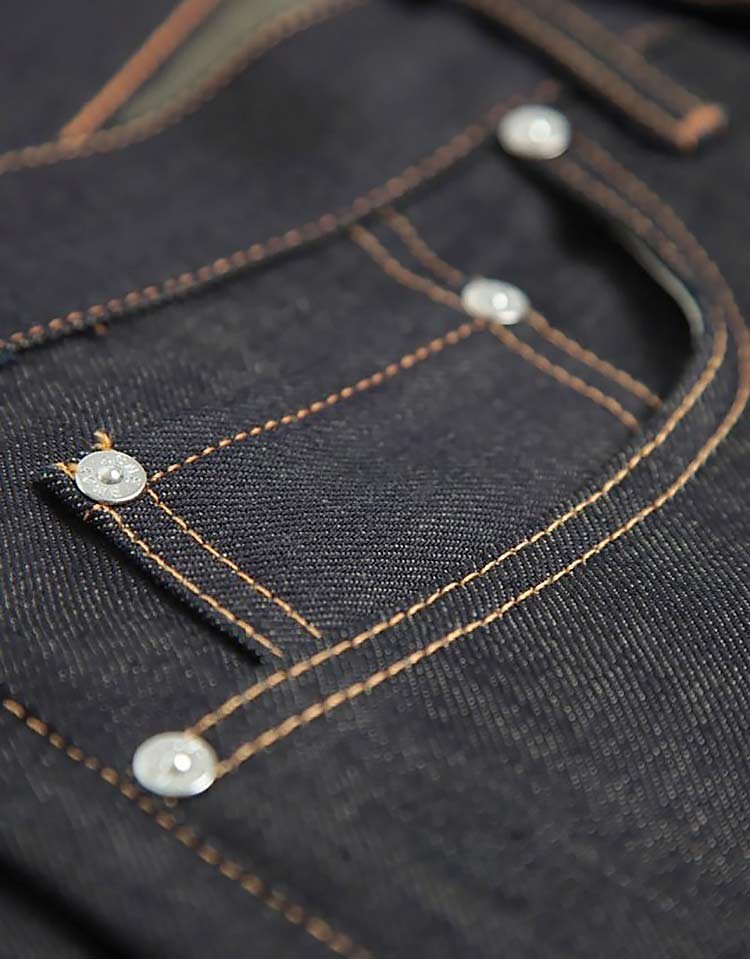
Raw Denim
This is a type of denim that has not undergone any pre-washing or distressing treatments. It is essentially the purest form of denim, in its raw and untreated state.
Raw denim enthusiasts appreciate this type of denim for its ability to develop unique and personalized fading patterns over time, as it adapts to the wearer's body. The absence of pre-washing also means that the fabric tends to be stiffer and requires some breaking in before it becomes more comfortable to wear.
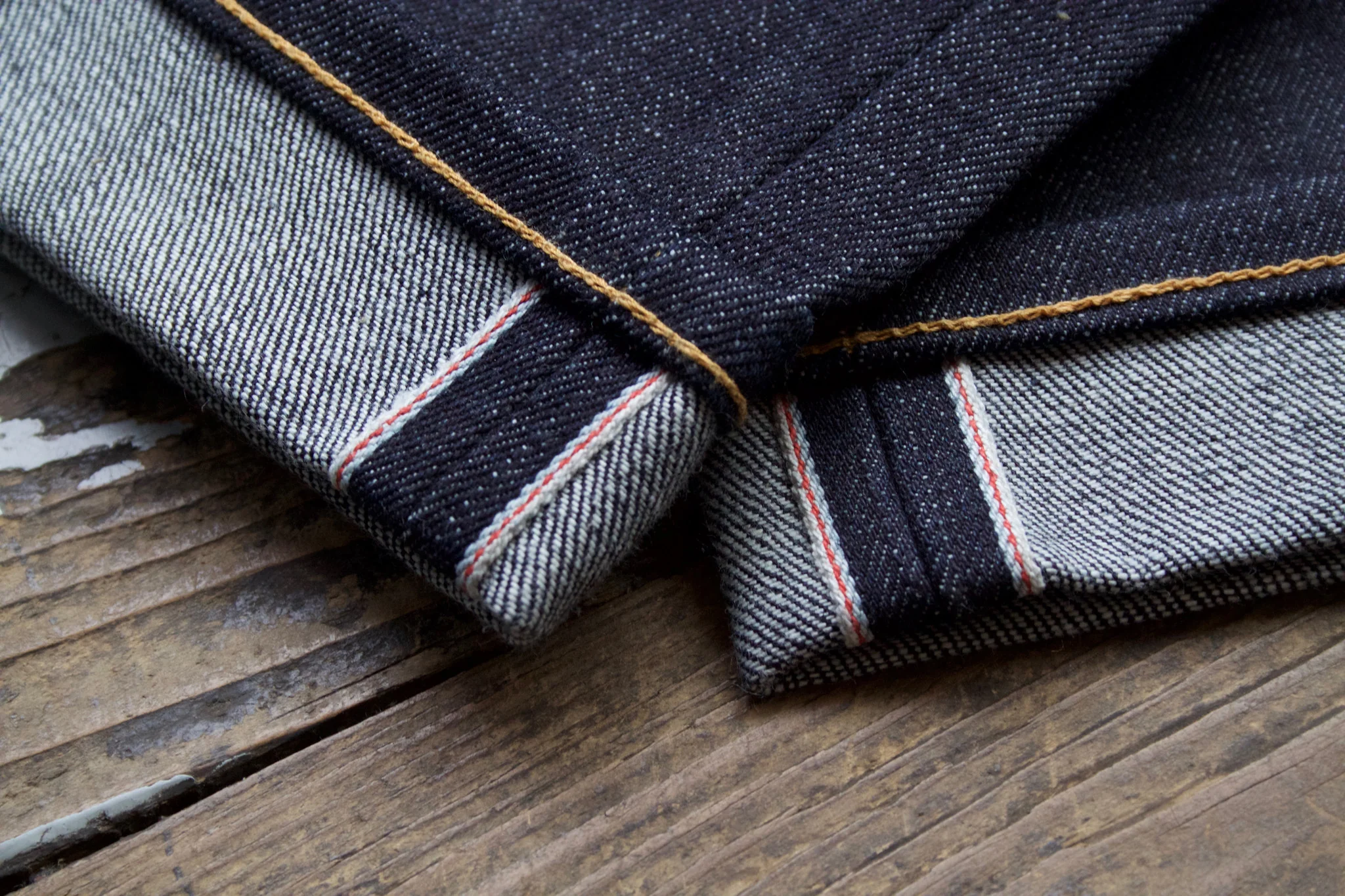
Selvedge Denim
Selvedge denim refers to a type of denim fabric that is woven on traditional shuttle looms. Unlike modern denim, which is often produced on large, automated machines, selvedge denim is woven slowly and meticulously on narrower looms, resulting in a unique and durable fabric. The term "selvedge" refers to the self-finished edges of the fabric, which are tightly woven and prevent fraying or unraveling.
Selvedge denim is known for its high quality and character, as the slow weaving process creates a tighter, denser weave and a distinct diagonal pattern known as the "selvedge edge." This type of denim is favored by denim enthusiasts and collectors for its authenticity and craftsmanship.
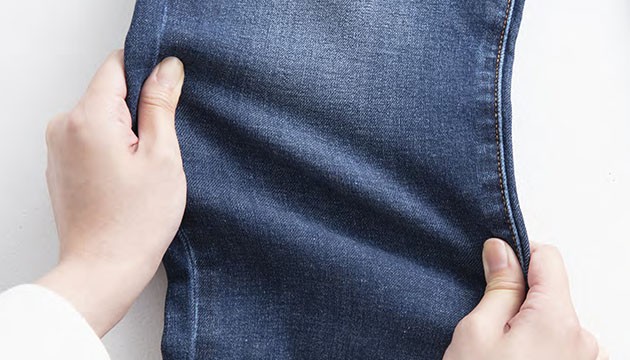
Stretch Denim
Stretch denim is woven with other fabrics to make it more stretchy and comfortable. Some jeans may have two to three percent spandex and others might have polyester blended into them. Stretch denim is known for its ability to retain its shape and provide a fitted look without feeling restrictive and it has become increasingly popular among consumers due to its comfortable and flexible qualities.
A quick thought if you go with spandex blends:
Spandex blends, while a little more comfortable and forgiving in the thighs, tend to stretch out and not retain their shape as well as 100% cotton blends.
Common Styles or Fits of Jeans
Before going into the details of which jeans you should be wearing, we need to discuss the different styles of jeans (also known as the 'fits' or 'cuts') as you will want to pick the right fit depending on your body type.
Be wary of what the labels say as far as the fit is concerned as there is no universal naming scheme and every brand uses whatever they want in this regard.
Here are the most common styles (in order of slimness):
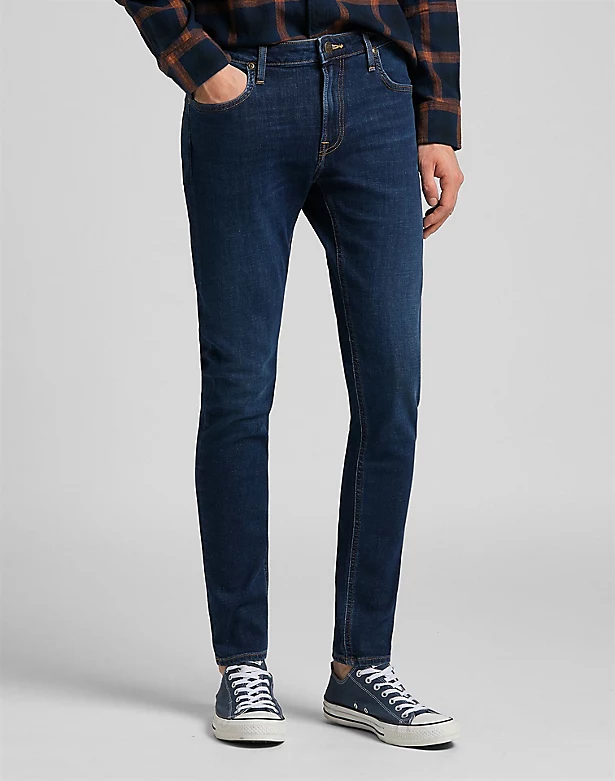
Skinny
Skinny jeans are characterized by their tight-fitting and slim-cut design.
These are typically made from stretchy materials such as denim or cotton, allowing them to hug the legs closely from the waist down to the ankles.
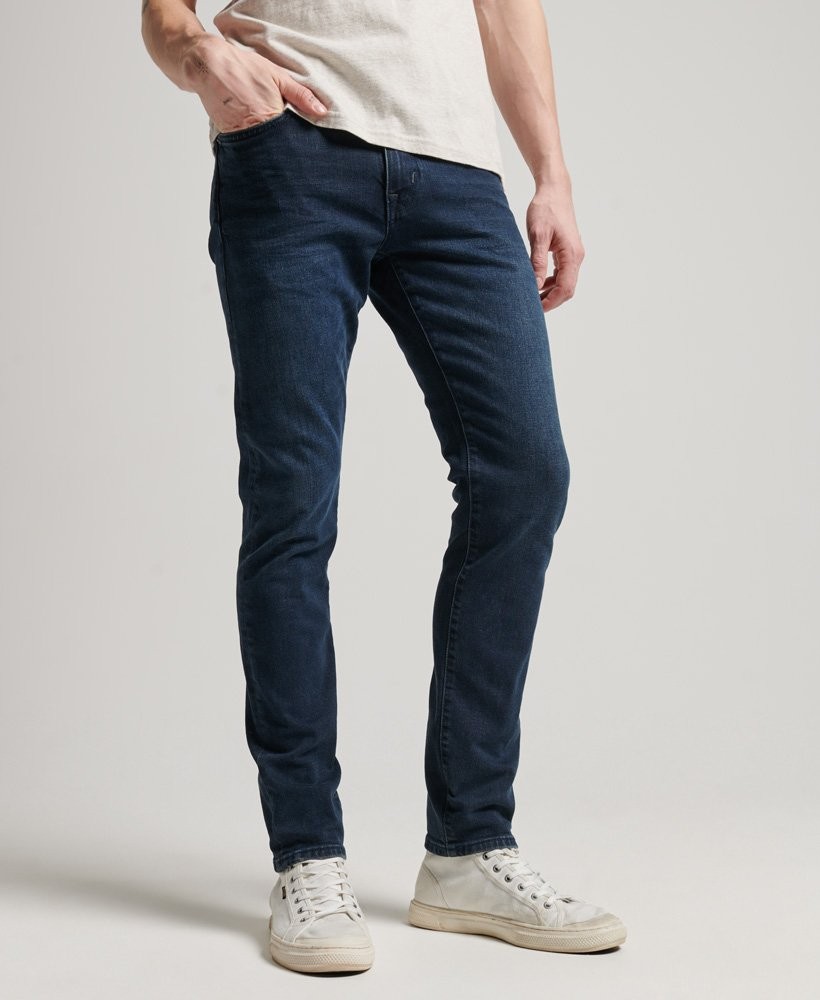
Slim
Slim-fit jeans are a popular style of jeans that are designed to fit closely to the body (but not as closely as skinny jeans).
These have narrow leg openings and snug fit through the thighs to the ankles.
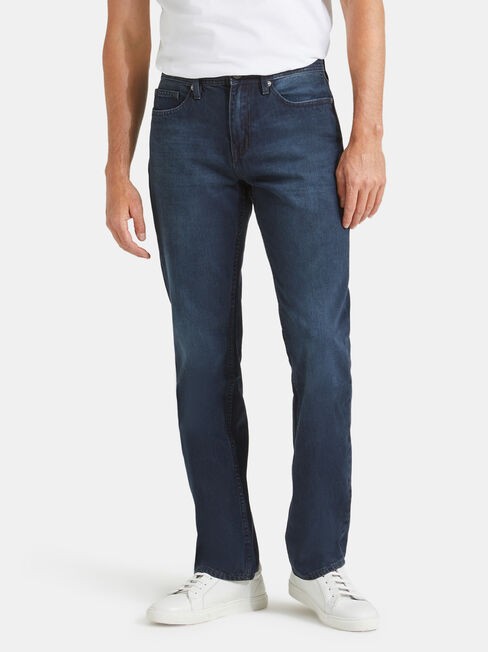
Straight
Straight-fit jeans are designed to have a consistent straight cut from the hips down to the ankles.
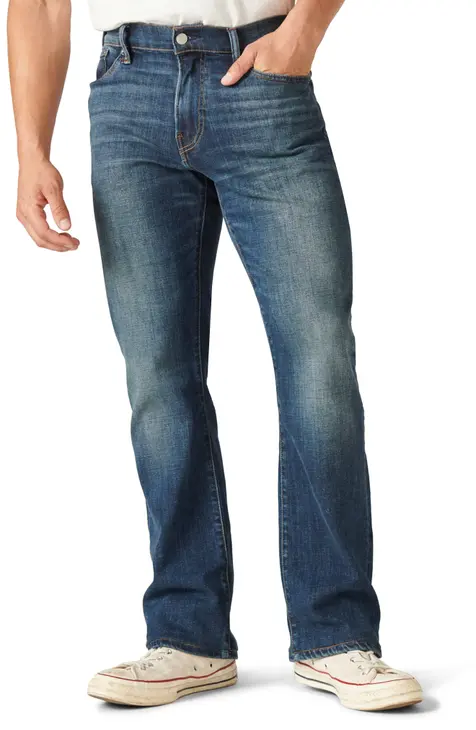
Boot Cut
Bootcut jeans are shaped to drape over a pair of cowboy boots and are a mainstay of Western clothing.
They are fitted through the waist and hips and then gradually widen from the knee to the ankle. Only wear these with cowboy boots.
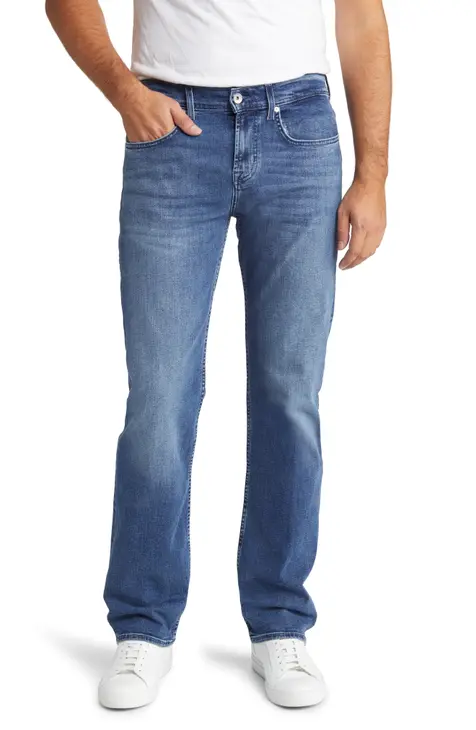
Relaxed
Relaxed-fit jeans have a roomier cut from through the leg and have become a popular choice for Gen Z and streetwear aficionados.
How Men's Jeans Should Fit
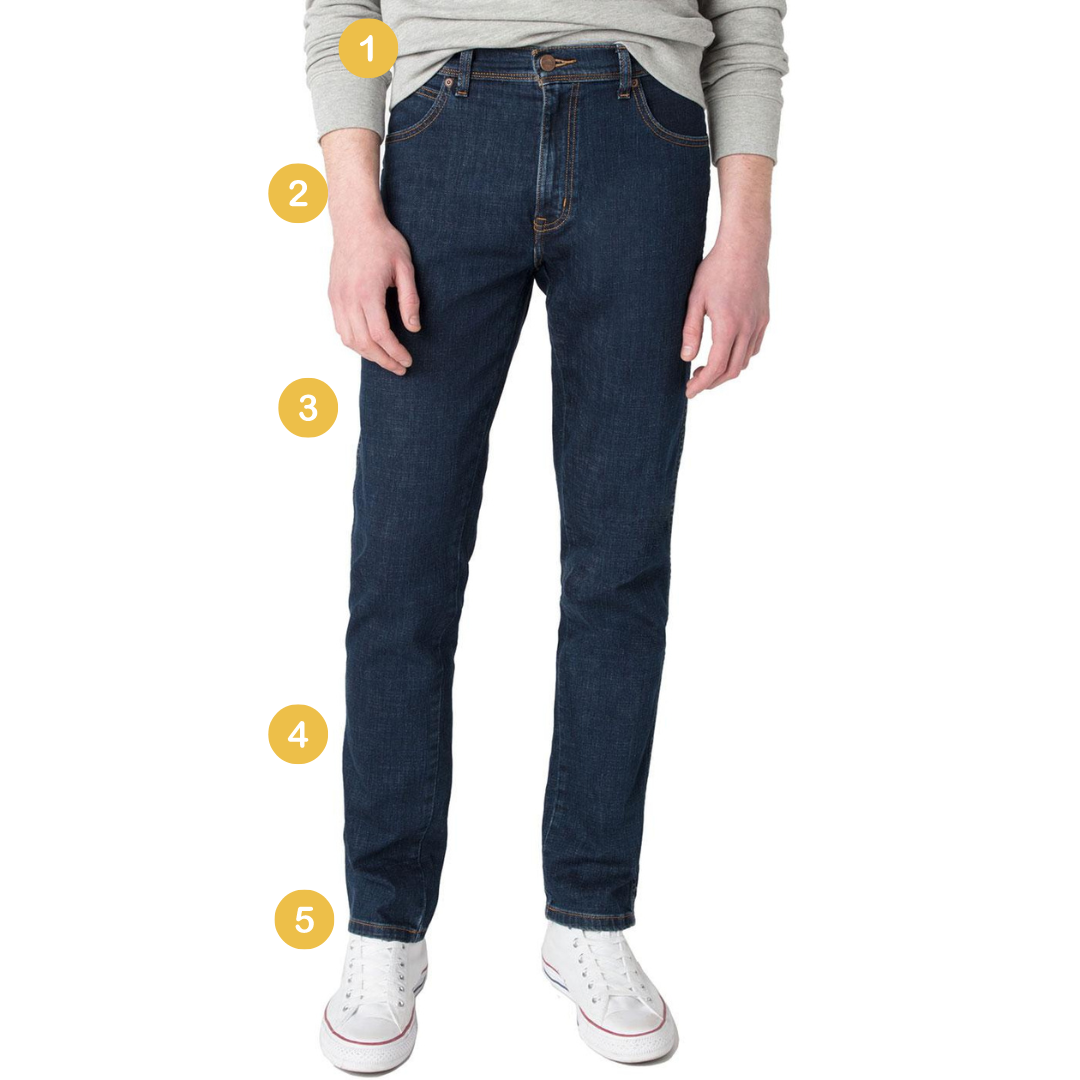
Waist: snug, no belt; slight tightness is fine—they’ll stretch with wear.**
Seat: should lightly hug your butt, neither too tight nor baggy.**
Thighs: pinch up to 2 inches (5cm) of fabric.*
Calves: pinch 1 to 2 inches (2.5cm to 5cm ) on either side.
Hem: half or no break*, with minimal fabric bunching at the ankle.
* Cheap & easy to tailor.
** Expensive & hard to tailor. Find a brand that fits better off the rack.
*Expensive to tailor so make sure that this area fits well off the rack.
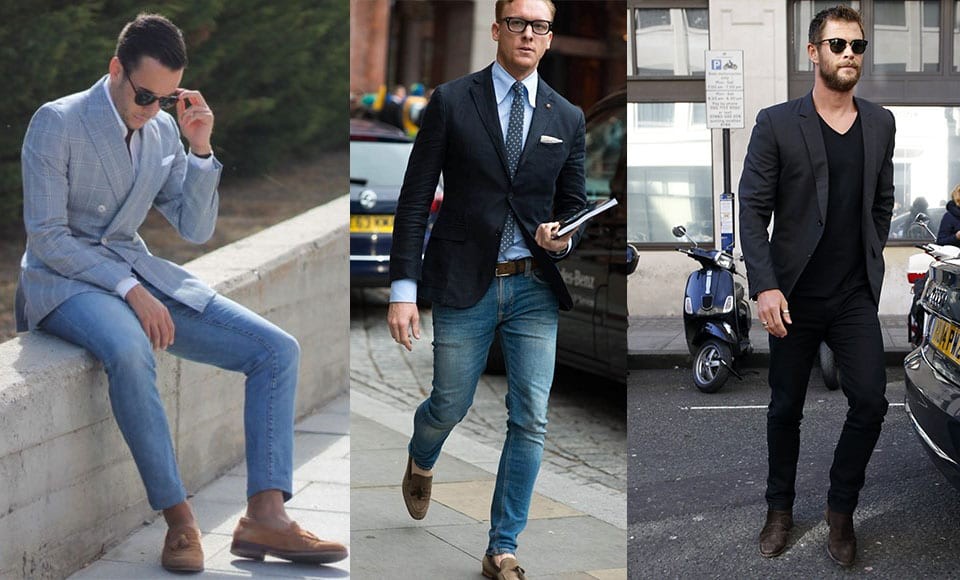
Best Jeans For Your Body Type
Before we get into which cut you should choose, here's a quick note about height: It doesn’t matter. The only thing that matters is your build: slim/regular or larger.
Skinny, Slim, Short, or Regular Build
You’ll want to get a “Slim” fit. Slim-fit jeans tend to slightly hug the thighs, knees, and calves while tapering down from your knee to your ankle.
A lot of guys initially believe this style will make them look too skinny, which couldn’t be further from the truth. It’s just that they’re used to wearing baggier clothes to try and hide their slimness, which, coincidentally, just makes them look slimmer.
A properly fitting pair of jeans just looks right, regardless of your build, and doesn’t make you look one way or another.
Things to Avoid:
Don’t make the mistake of thinking a “Skinny” fit is the same as a “Slim” fit.
“Skinny” fit jeans are usually skin-tight and not appropriate. Unfortunately, a lot of brands interchange the name of their cuts, so at least try them on.
Avoid "Skinny Fit" jeans. They'll only make you look skinnier than you are - don't do it.
Avoid “Straight Fit” jeans. As the name implies, the leg of the pants are looser and will be cut straight down from the knee to the ankle. This cut will look terrible on you.
If you can pinch more than 2 inches (5cm) of denim on either side of your thigh and the widest part of your calf, you may need to move down to a slimmer cut or get the legs taken in.
If you can avoid it, don’t rush to the tailor. Try a size down first or another brand's slim cut. This is costly for a tailor to do and having too much fabric on your thighs or calf area will make you look smaller, skinnier, or shorter than you are.
Larger or Muscular Build
The classic “Straight-Leg” fit is perfect for you. It's all about balancing your body’s proportions to make sure your bottom half complements your upper half. Straight-legged jeans with a roomier thigh area, which will hopefully solve your frustrations with finding jeans that fit properly.
Things To Watch Out For:
Avoid any cut of jeans (all pants in general, for your build) with a taper at the legs. A taper will make you look really top-heavy - like Humpty Dumpty.
If you can pinch more than 2 inches (5cm) of fabric on either side of your thigh and the widest part of your calf, you need to move down a size, go to a different cut, try a different brand, or get the legs taken in by a tailor.
Having too much fabric on your thighs will make you look wider than you are and completely throw off your proportions.
Want to know how all your clothes should fit you, based on your age, height and body type? Check out my Essential Capsule Wardrobe App.
Best Ways To Pair Jeans With Shoes
There are many combinations of shoes and jeans/denim you can wear, but depending on the shoes, your jeans need to be certain colors and fit certain ways in order to look their best, so let me show you the best ways to wear jeans with High and Low top Sneakers/Trainers, Boots, Chukka Boots, Chelsea Boots, Work Boots, Dress Shoes, Brogues, Monk Straps, Loafers, Penny Loafers and more.
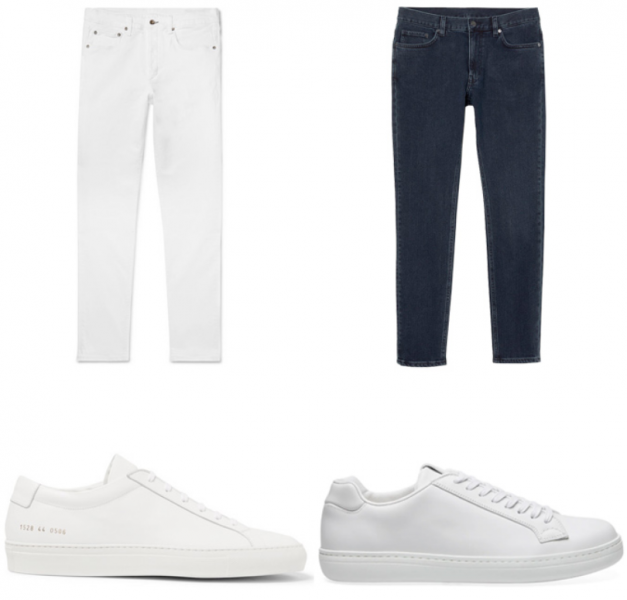
Low-Top Sneakers
Due to the low profile of low-top sneakers, it's really hard to mess this up and they’ll work with almost any cut of jeans.
As for denim colors or styles, unless they’re all-black sneakers, you can pretty much wear any color or style you want.
The one caveat is that if you’re wearing white sneakers and dark indigo jeans, they can stain the tops of the shoes. So soak the pants in cold water for about 30 minutes to get rid of any excess dye that may rub off on the shoes and then spot clean the shoes, as necessary.
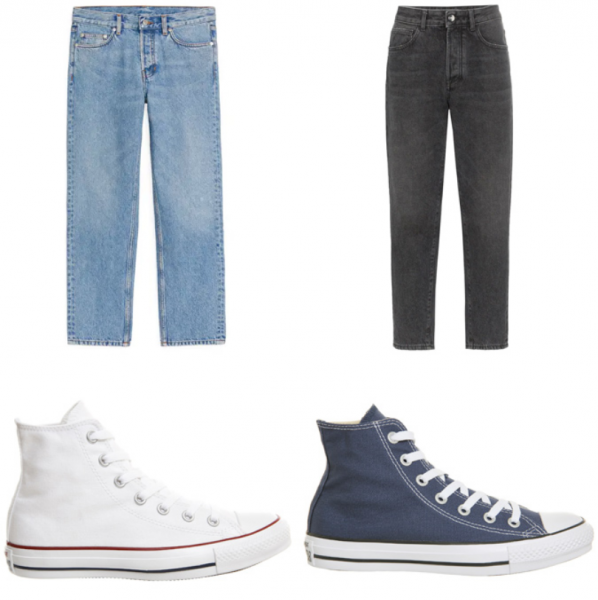
High-Top Sneakers
If you’re going to buy high-top shoes and wear them with the hem going past the tops of the shoes, you should just get a low-top pair of sneakers instead. It will literally look the same and low tops are more versatile anyways.
To do this well, either get your pants hemmed shorter, cut them with scissors for a frayed look to show off the shoes, or simply roll them to just above or below the top of the high tops. Never more than twice, though, otherwise you’ll have a really thick cuff on the bottom and it will look very heavy and throw off your look.
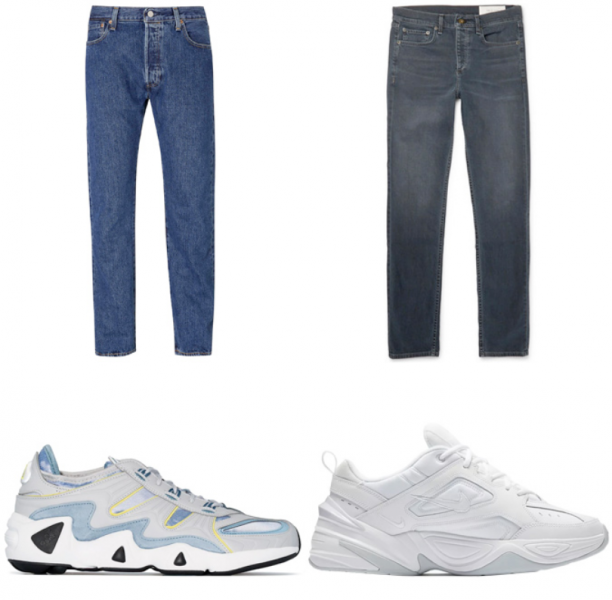
Athletic or Running Shoes
There are two schools of thought when it comes to athletic or running shoes, also called trainers and it depends on how “chunky” the shoes are. If they’re low-profile and sleek, then stick to a similar cut, as you do with low-top sneakers – which means wear any cut of jeans. You can even cuff your pants if you want a sportier look.
If they're chunky, you should be a bigger guy since these will require you to wear straight-cut jeans to fit over the thicker shoes. Otherwise, if you're thinner, your shoes are going to look really big and out of proportion with the rest of your outfit, so I say avoid it altogether unless you're explicitly going for that look.
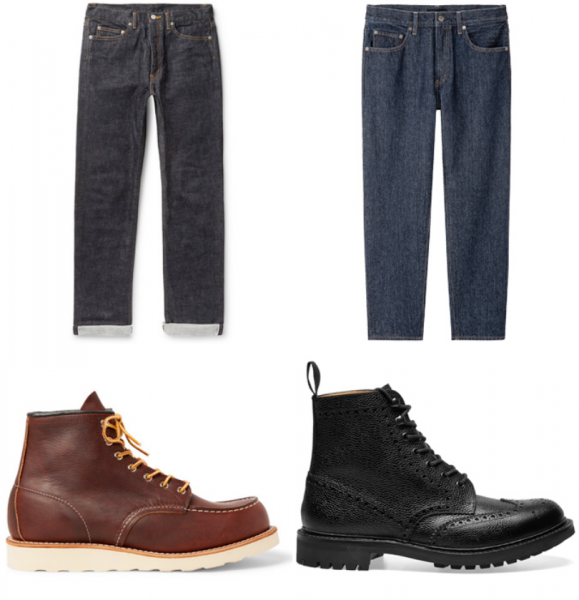
Boots
Dress boots will pair really well with dark-wash or black jeans. Just make sure your jeans have a slight to no break to match the sleeker and more polished dress boots. Wearing dress boots and stacked jeans (lots of folds at the ankles) is like wearing tuxedo shoes with jogger pants – it just doesn’t look good.
Work boots tend to have a chunkier sole and a more casual appearance, so definitely play up the workwear version and wear them with dark wash denim or denim that has some fading. And cuffed or uncuffed, you can wear them any way you want. If you’re going for the super slim fit jean and chunky boot look, get them hemmed or roll them up to be shorter and leave no break. If you want a super vintage look, then try a single, oversized cuff and a more relaxed fit.
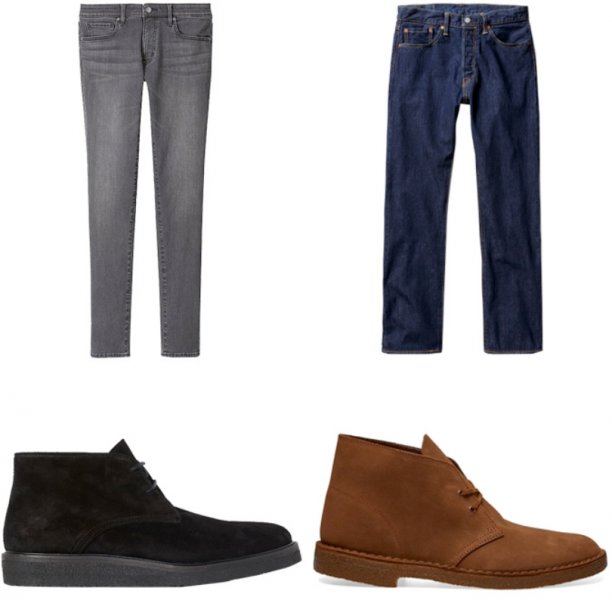
Desert and Chukka Boots
Wear your Desert or Chukkas Boots in any color and cut of jeans you prefer and they tend to look best with a slight or no break, depending on the look you’re going for. You can achieve this by cuffing your jeans or getting them hemmed.
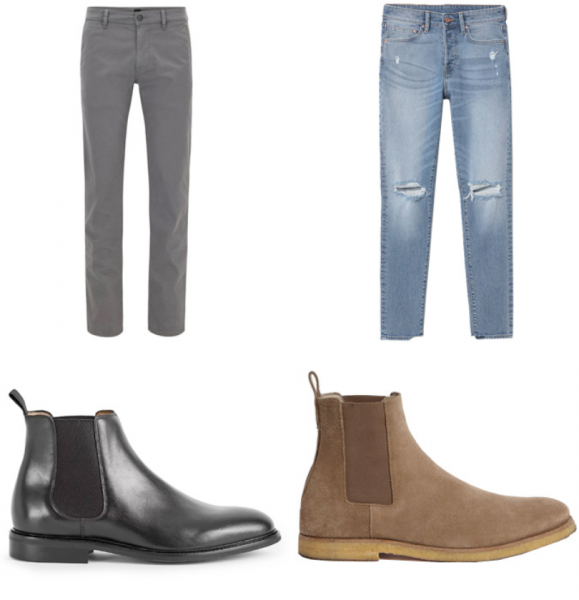
Chelsea Boots
Chelsea Boots are not for everyone- if you’re a bigger guy, stick to work boots unless you want to look like Humpty Dumpty with little tiny legs. Chelseas need to be paired with slim jeans to look their best. The color and material of the boots will determine what you should pair them with.
If you’re wearing black leather or suede Chelseas, they’ll look best paired with black or gray slim or skinny jeans. Anything outside of this will be much harder to pull off.
For brown or tan suede Chelseas, especially with a gum sole, go with lighter blue or gray denim, which can also have some distressing.
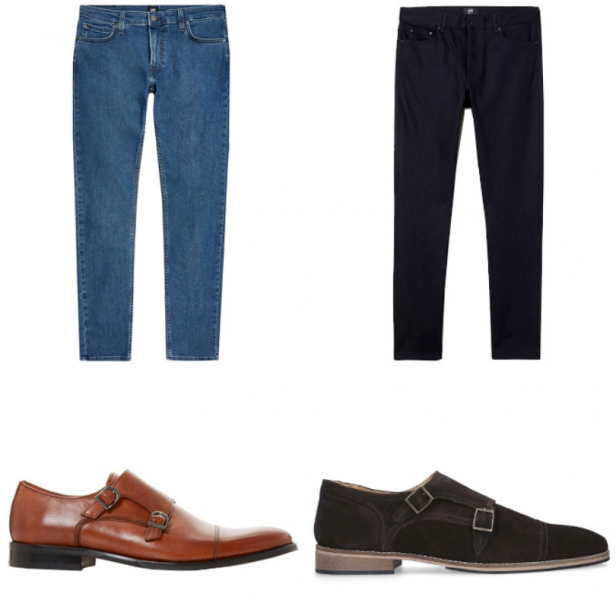
Dress Shoes -
Oxfords, Derbies, Brogues, Wingtips, Monkstraps
Derbies feature a chunkier profile, so they’re better suited for casual outfits that include denim. Black derbies look great with black or dark blue denim, while brown derbies look great with dark blue or medium blue denim.
For brogues, as a general rule, the sleek, minimally detailed brogues will skew more formal, while chunky, hole-punched ones will skew more casual. The color of the shoes affects which jeans your brogues will or won’t work with, going from black at the formal end and getting gradually lighter towards the casual end will work best. Casual medium brown brogues pair well with indigo or lighter denim while other colors like oxblood and black will look good with black denim. As for cuts, they’ll work for any cut of denim you wear.
You can pull off Oxfords with black or indigo jeans, as long as they’re slim, and either cuffed or hemmed with no break so they’ll feel a little less casual, but still sleek and polished.
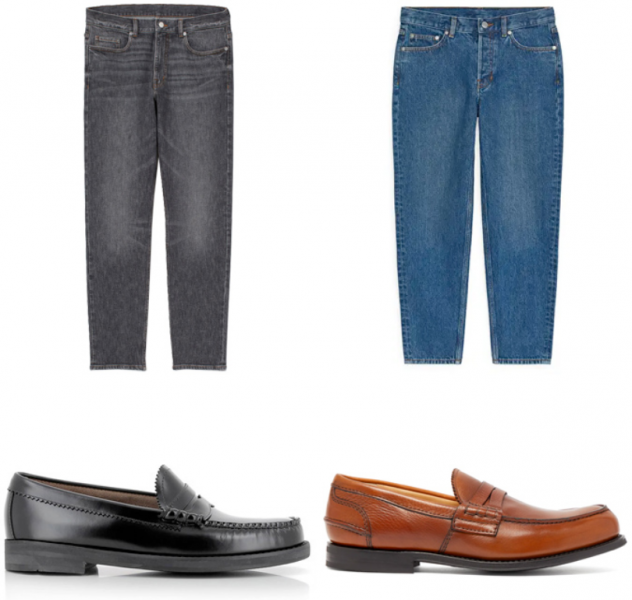
Loafers & Penny Loafers
The penny loafers’ low vamp (that’s the section of upper that covers the front of the foot) combined with a wide leg opening can make your feet look weirdly stubby. So opt for jeans that are tapered and cropped or pin-rolled. If you don't have the body to wear jeans with a slight taper, this look isn't for you.
As for colors, a brown pair goes well with dark wash indigo but can also be paired with any lighter colors up to white denim. Black penny loafers will look great with gray, black, or indigo denim.
How to Wash, Dry & Care For Your Jeans
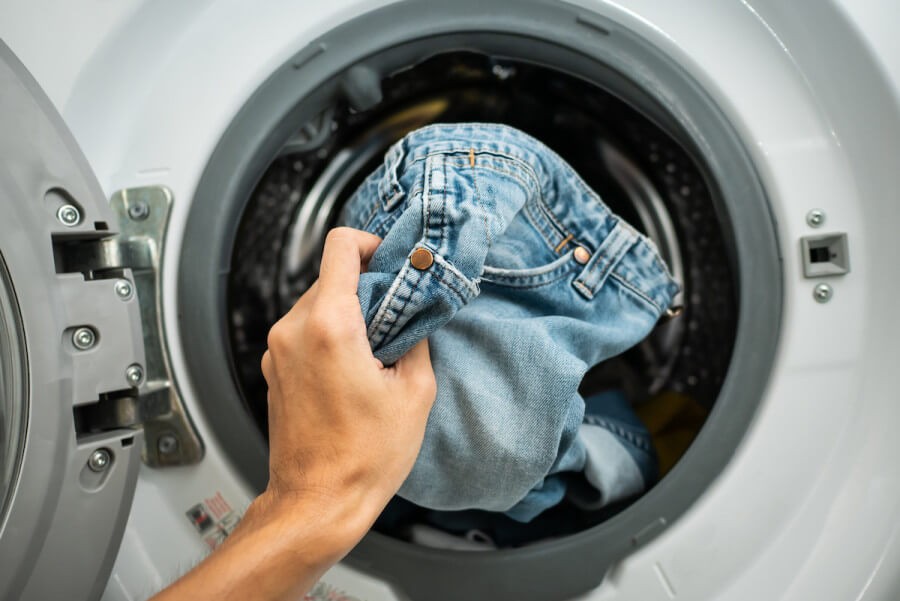
Washing
If you're looking to make your jeans last as long as possible, then you should only wash them when they smell or have stains. Otherwise, turn them inside out and air them out overnight or between wears.
When you do need to wash them:
Turn them inside out
This will protect the color and minimize fading
Use cold water and a mild color-preserving detergent
This will prevent any damage to the fabric.
Avoid using harsh detergents or bleach as they can weaken the fibers.
Put them on a gentle wash cycle.
It is also advisable to wash denim jeans separately or with similar colors to avoid any potential color transfer.
Overwashing can cause the fabric to wear out faster, so it is important to find a balance between cleanliness and preserving the longevity of your jeans. Generally, it is recommended to wash them after every 5-10 wears or until there are visible stains. This helps to maintain their shape, color, and overall quality.
Drying
After washing, hang your jeans to air dry or lay them flat to prevent any shrinkage. It is generally best to air dry jeans rather than using a dryer, as this can help maintain their shape, preserve the color, and prevent shrinkage.
Storage
Storing jeans properly is important to maintain their shape and longevity. The best way to store jeans is to fold them neatly and stack them in a drawer or on a shelf. Hanging jeans can cause them to stretch out and lose their shape over time. If you must hang your jeans, use clip hangers to avoid creating creases or marks on the waistband.
Outfit Ideas
Casual
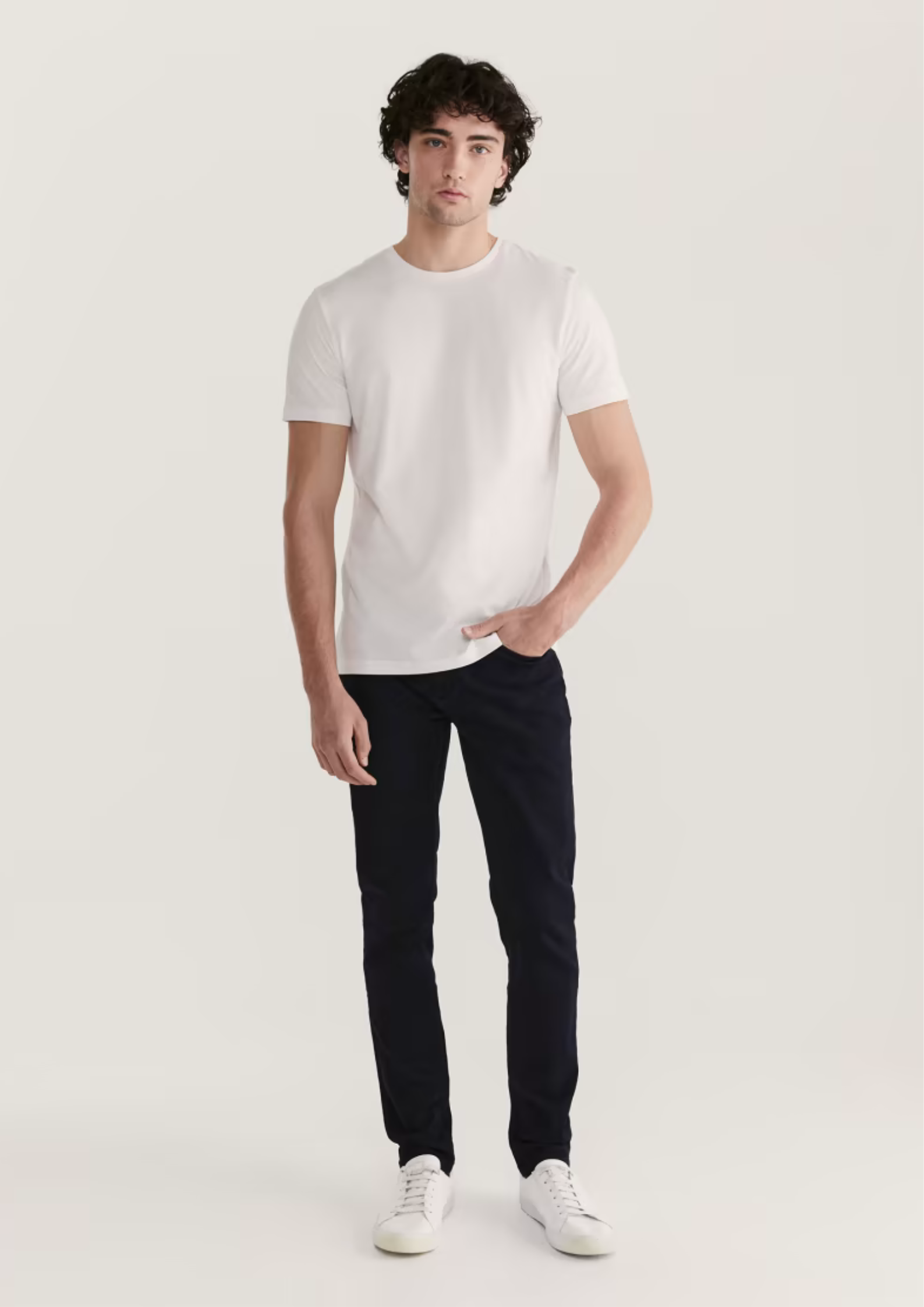
White Crewneck T-Shirt
Black Jeans
White Low-Top Sneakers
This outfit could not be easier to throw together. Feel free to swap out the black jeans for a dark blue pair instead and the white t-shirt could always be changed up for a heather gray or navy version. Layer a mid-wash or olive trucker jacket or a navy bomber on top to complete the look if it's not too hot.
These are only some of my favorite ways to put jean outfits together. My app has many more options and details that are specific to your age, height, body type, and skin tone.
Elevated Casual
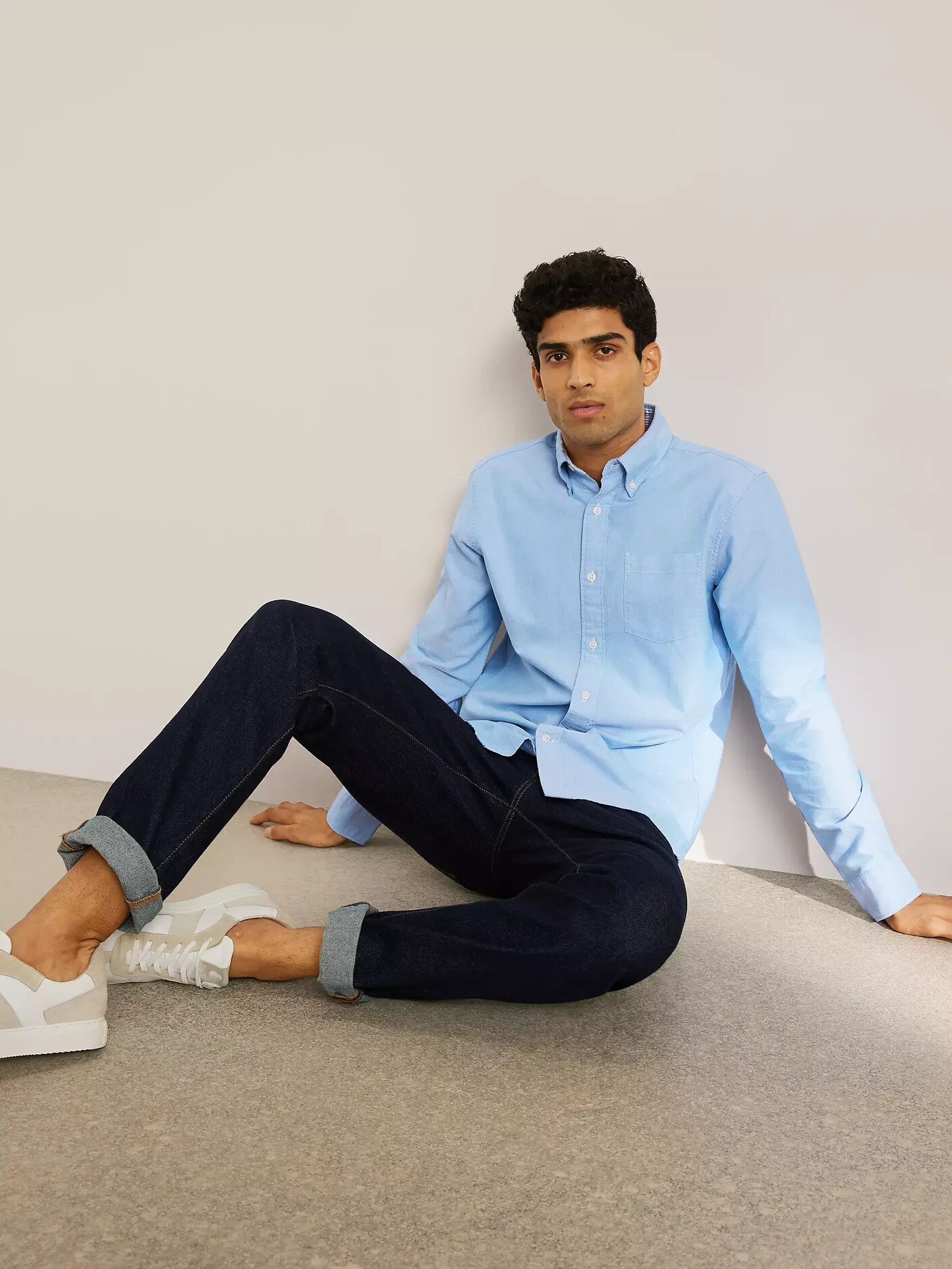
Blue Oxford Shirt
Dark-Wash Jeans
White Low-Top Sneakers
An Oxford shirt paired with jeans and sneakers has got to be one of the most fool-proof outfit combinations out there for an elevated casual look. The light blue Oxford works really well here, but if you wanted, you could always go for a white version instead. To elevate it further, throw on a blazer or bomber jacket and swap the shoes out for loafers, chukkas, or another boot.
Business Casual

Charcoal Sports Coat
Navy V-Neck Sweater
White Oxford Shirt
Dark-Wash Jeans
Brown Dress Shoes
We've got some expert-level business casual layering going on here. Notice the cut of the jeans here if you're muscular or bigger. This combo works for every body type and would also work if you wanted to remove the sweater, and went with the dress shirt only, just make sure you have a brown belt in a similar shade to the shoes. Speaking of shoes, chukka boots or regular lace-up boots could also work here, but they'd be a little less polished than dress shoes.